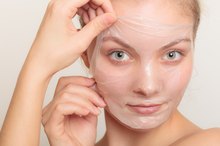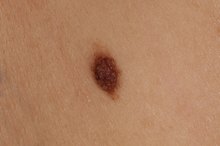Difference Between Jessner & TCA Peels
Chemical peels are used to treat different skin problems such as acne, sun spots, fine lines, wrinkles, and uneven skin tone and texture. They involve the use of chemicals such as glycolic acid, salicylic acid, Jessner's solution, trichloroacetic acid (TCA) and phenol. The chemical is applied to your skin and then removed after some time. The top layer of your skin peels off as a result, revealing newer, more youthful-looking skin. TCA and Jessner peels are two popular types of chemical peels.
History
Jessner's solution, which is used for a Jessner peel, was originally formulated by Dr. Max Jessner and has been in use for over 100 years. He formulated this solution out of several different chemicals to reduce the toxic effects of each individual component.
A German dermatologist named P. G. Unna described the use of trichloroacetic acid as a peeling agent in 1882. According to "The Color Atlas of Chemical Peels," important discoveries have been made about TCA over time, such as the fact that it can be used in combination with other chemicals or peeling agents.
- Jessner's solution, which is used for a Jessner peel, was originally formulated by Dr. Max Jessner and has been in use for over 100 years.
- According to "The Color Atlas of Chemical Peels," important discoveries have been made about TCA over time, such as the fact that it can be used in combination with other chemicals or peeling agents.
Strength
Maxi Peel Ingredients
Learn More
TCA peels are available in different strengths or concentrations. The stronger the solution is, the deeper it penetrates the different layers of your skin. Superficial peels are done with 10 to 20 percent and 25 to 35 percent TCA; medium-depth peels are done with 40 to 50 percent TCA; and a deep peel results from the use of greater than 50 percent TCA. According to "The Color Atlas of Chemical Peels," the use of TCA with a concentration above 35 percent gives unpredictable results such as scarring. The book "Aesthetics and Cosmetic Surgery for Darker Skin Types" states that TCAs at concentrations of 50 percent have been discontinued because it puts dark-skinned patients at risk for hypopigmentation, hyperpigmentation and scarring 3.
Jessner's solution is available in one strength only, but the depth to which it penetrates your skin can be increased by applying several layers of the solution during a Jessner peel.
- TCA peels are available in different strengths or concentrations.
- Jessner's solution is available in one strength only, but the depth to which it penetrates your skin can be increased by applying several layers of the solution during a Jessner peel.
Content
Jessner's solution is made with 14 g of resorcinol, 14 g of salicylic acid (a beta hydroxy acid) and 14 g of lactic acid (an alpha hydroxy acid) dissolved in enough ethanol to make 100 cc of solution. Beta hydroxy and alpha hydroxy acids are typically used for superficial chemical peels. Resorcinol is structurally and chemically identical to phenol, a chemical used for deep chemical peels. Some people are allergic to resorcinol, and because of this Jessner's solution can be modified to exclude this component.
TCA peels are done with a solution of trichloroacetic acid, which is made by dissolving a certain amount of trichloroacetic acid in enough water to make 100 cc of the solution.
- Jessner's solution is made with 14 g of resorcinol, 14 g of salicylic acid (a beta hydroxy acid) and 14 g of lactic acid (an alpha hydroxy acid) dissolved in enough ethanol to make 100 cc of solution.
Uses
A Chemical Peel for Enlarged Pores
Learn More
A Jessner peel, according to the book "Aesthetics and Cosmetic Surgery for Darker Skin Types," is a superficial peel that is used to treat photoaging, age spots, acne, post-inflammatory hyperpigmentation, melasma and freckles 3. Jessner peels should not be used on pregnant women or people who are allergic to any of its components.
TCA peels are used for superficial- or medium-depth peels and can treat moderate photoaging, actinic keratosis, blotchy hyperpigmentation, melasma, mild to medium rhytides and superficial acne scars.
Side Effects
According to "The Color Atlas of Chemical Peels," a Jessner peel has minimal side effects 1. However, its resorcinol and salicylic acid components have the potential to cause thyroid disease and salicylism, respectively. Some symptoms of salicylism are ringing in the ears, dizziness, confusion or disorientation. However, there have been no reported cases of salicylism, according to "Aesthetics and Cosmetic Surgery for Darker Skin Types. 3"
Some complications of TCA peels are bacterial, viral or fungal infections, skin scarring, acne and change in your skin's texture.
Related Articles
References
- "Color Atlas of Chemical Peels"; Antonella Tosti, Maria Pia De Padova; 2006
- "Cosmetic Dermatology: Principles and Practice"; Leslie Baumann; 2009
- "Aesthetics and Cosmetic Surgery for Darker Skin Types"; Pearl E. Grimes; 2007
- Hospital for Special Surgery: Aspirin Still a "Miracle Drug" but Caution Required!
- American Society for Dermatologic Surgery: Chemical Peels Information
- Arif T. Salicylic acid as a peeling agent: a comprehensive review. Clin Cosmet Investig Dermatol. 2015;8:455-61. doi:10.2147/CCID.S84765
- Nikalji N, Godse K, Sakhiya J, Patil S, Nadkarni N. Complications of medium depth and deep chemical peels. J Cutan Aesthet Surg. 2012;5(4):254-60. doi:10.4103/0974-2077.104913
- Arif T. Salicylic acid as a peeling agent: a comprehensive review. Clinical, Cosmetic and Investigational Dermatology. 2015 Aug 26;8:455-61. doi:10.2147/CCID.S84765
Writer Bio
Ngozi Oguejiofo has been writing on a freelance basis since 2009 and most of her writings are focused on health. She is currently a registered nurse. She is interested in teaching, and writes articles focused on student nurses for various online publications.









